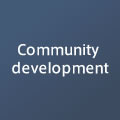Daiwa House Group’s Developing new communities
Each house is fitted with three batteries, and a home energy management system (HEMS) that enables easy tracking of energy usage
SMA×ECO CITY Tsukuba Science City (sales completed)
SMA×ECO CITY Tsukuba Science City has been positioned by Tsukuba City (an "environmental model city") as a low-carbon residential community. Each single-family house is fitted with a photovoltaic power generation system and two batteries, and all electric power and communication lines are laid underground. Every effort has been made to realize a low-carbon lifestyle through measures to help residents reduce their volume of carbon release into the atmosphere.
- Development area: 51,420.46m2
- Total units: 175 single-family houses, 1 community meeting place
![]()
The city of Tsukuba has for some years been promoting an environment-friendly plan under the name of "Tsukuba Environment Style—SMILe." As a result, in March 2013 the government of Japan designated Tsukuba as an Environmental Model City. The area surrounding the project discussed here has been positioned as a low-carbon residential community, and the municipality has been planning the creation of a large-scale residential development that will also be a "smart community."
Daiwa House Industry has studied the idea of amalgamating the Tsukuba Environment Style—SMILe concept with its own SMA×ECO PROJECT to realize an eco-friendly model community. Each single-family house is fitted with three batteries (a photovoltaic power generation system, a lithium-ion storage battery, and a fuel-cell battery), as well as an HEMS* that enables tracking of energy use. This means that energy use by the residential community as a whole can also be monitored.
When the SMA×ECO CITY was developed, there were still few examples of such developments. Under the "smart city" concept being promoted by the government, it was approved as a large-scale single-family house development in the Tokyo catchment area, and in fiscal 2012 the Ministry of Land, Infrastructure, Transport and Tourism selected it as one of the ministry's projects for the construction of model communities making use of renewable energy generation and storage, and energy conservation at the levels of both the whole community and individual homes, as well as in transport. Daiwa House had access to advice from various experts with regard to the methods to be used in the project.
SMA×ECO CITY Tsukuba Science City was a pioneering project in the environs of Tsukuba, which has been designated as an Environmental Model City, and the authorities have pointed out the need to foster an understanding among the public of the concept of low-carbon urban development, as well as for collaboration among private-sector companies and academic institutions in collecting practical data. Regarding the larger surrounding area, it was recognized that the plans would have to take account of the single-family house developments already built on neighboring plots, as well as the simultaneous plan for a condominium building on an adjacent plot, so as to harmonize these various elements. Daiwa House set to work to tackle these issues.
*HEMS: Home Energy Management System. Systems that employ ICT to assist residents in managing their energy use patterns.

Cables laid underground to avoid recurrence of typhoon-caused damage
During the development of this community, the city of Tsukuba had recently suffered power blackouts caused by the toppling of utility poles by strong winds, including a typhoon. To prevent a recurrence of such damage, the new community was designed with all cables laid underground.
In the event of a failure of electrical power supply in a natural disaster, generating equipment in the meeting place can be used as a temporary power source.
Portions of the surface of the roads within the residential development have been surfaced with interlocking blocks so as to alert drivers to the fact that they are approaching an intersection. The community also features numerous pedestrian-only paths, and the development has been planned so that the number of intersections between roads and paths is minimized.
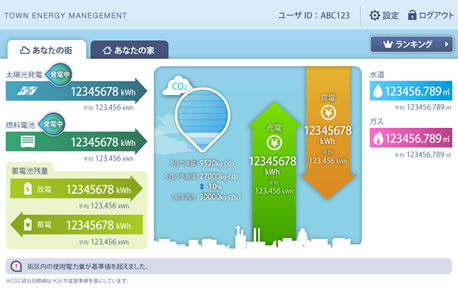 Energy use for the whole community is easily monitored visually
Energy use for the whole community is easily monitored visually
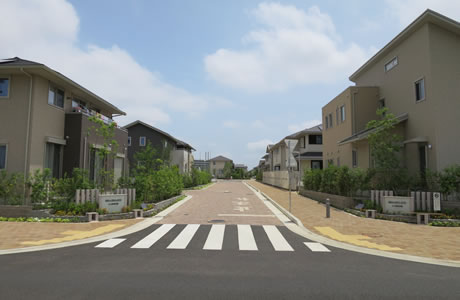 The use of interlocking blocks to surface the roads at certain points alerts drivers to the approach of intersections, etc.
The use of interlocking blocks to surface the roads at certain points alerts drivers to the approach of intersections, etc.

Collaborative efforts made with city and local universities under leadership of the community’s management association
The Daiwa House Group has provided support for the establishment of a residents' management association for the purpose of maintaining and enhancing community activities and spirit. The Group has shared the work of managing the common-use portions of the development with the community’s management association, and has helped the association to get going in other ways. At the beginning, we stationed support staff at all times at the meeting place to encourage its use by the residents.
The single-family house development of SMA×ECO CITY Tsukuba Science City was developed through a joint venture with the adjacent condominium building and existing single-family houses. So that the entire development can function as a single community for the residents, we have also supported the holding of liaison meetings between the various residents' associations.
In collaboration with academic and research institutions and the local municipality, the community’s management association and the residents' management association took a number of measures to inform the residents of the importance of building a community spirit and encourage their active participation. Seminars and forums were held in fiscal 2014, 2016, and 2017. We also held guided tours for students and staff from local universities, allowing them to see this example of urban development. In these and other ways, we have made a contribution to education and academic inquiry. Other efforts have included the publication of a community newsletter twice a year, the drafting by the board of governors of the residents' association of an illustrated handbook explaining the community's landscaping rules, and the holding of various events in the summer.
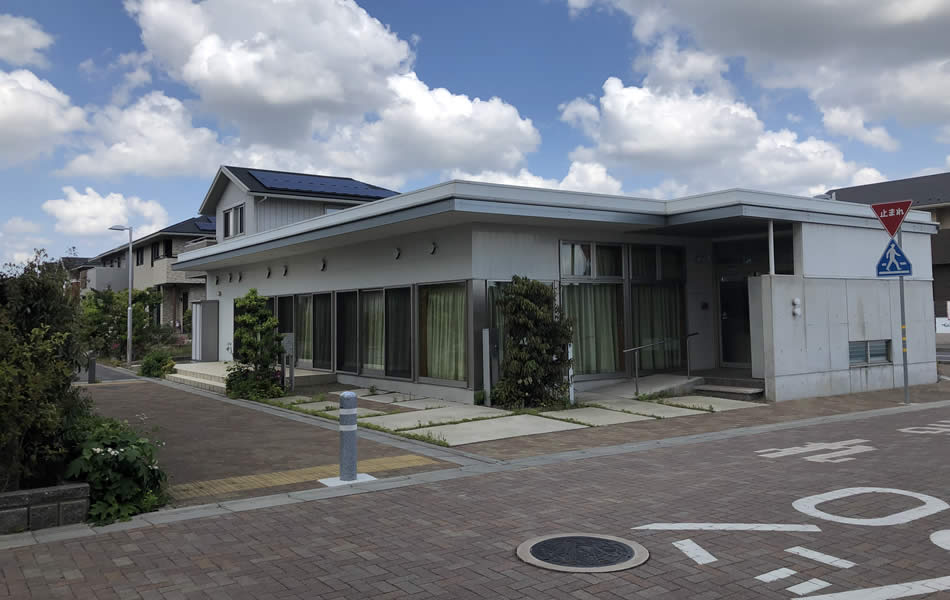 The community meeting place, which also serves as a base for environmental activities
The community meeting place, which also serves as a base for environmental activities

Establishing a system enabling residents to proactively maintain the community's visual attractiveness
To ensure the continued maintenance of commonly-owned assets such as the meeting place, common-use areas, green belts, etc., the Group provided support for the establishment of a community’s management association.
To maintain the external appearance of homes and the greenery planted in and around the land used for housing, we drew up a landscaping agreement (approved by Tsukuba City), and to ensure the continued observance of this agreement by the residents, we established a Landscaping Agreement Committee. At the start of activities by the committee, we commissioned a group of experts to provide advice to the committee, in addition to other measures to support its activities.
By laying all cables underground we avoided the ugly visual clutter caused by utility poles, and the pleasant scenery of the resultant housing development was even used in a TV commercial by an automaker.
To contribute to improving the community's natural scenery, the residents' management association organizes a Community Clean-up Day, and the community’s management association organizes patrols around the community to check that the landscaping is being kept in good condition.
Daiwa LifeNext Co., Ltd. provides support for the community's management association's operational clerical work.

All houses fitted with three batteries
Each of the 175 houses is fitted with three batteries (a photovoltaic power generation system, a lithium-ion storage battery, and a fuel-cell battery), and the homes' specifications conform to the definition of a net zero-energy house (ZEH*1). This is the first time that Daiwa House has created a housing development on this scale with all homes being both ZEH and fitted with home energy management systems.
To facilitate easy visual monitoring of energy usage for the community as a whole, we have incorporated a system that makes it easy to track and understand the electric power, water supply, gas supply, and CO2 emissions of the whole housing development. The system was fully up and running by March 2018.
Half of the homes include a "coconatch"*2 (a robotics product that can fit in the palm of a hand) as a means of making it easier for residents to visually monitor the home's energy usage.
 This "coconatch" robotics product informs home owners visually that energy usage data is available.
This "coconatch" robotics product informs home owners visually that energy usage data is available.
The data on energy usage collected from the 175 homes in the development is supplied to the Tsukuba municipal government to help them in testing their CO2 reduction efforts. The data is also analyzed at the Center for Low-Carbon Society Strategy within the Japan Science and Technology Agency (JST), as well as at research institutions within Tokyo University and the Shibaura Institute of Technology, and these institutions have published their findings in academic papers.
According to the "Report on Surveys of Energy Monitoring," delivered at the SMA×ECO CITY Tsukuba Science City Sustainable Community Forum 2018, the annual volume of CO2 emissions by the households in this community showed a 68 percent reduction compared with emissions by the average household in Japan. Looking at electric power use for all homes, households showing a power surplus exceeded those where power consumed was more than power produced, meaning that the development qualifies as a net zero energy community. (Figures released by Tomoko Iwata, Associate Professor, Shibaura Institute of Technology.)
The lithium ion batteries used in this housing development were developed by ELIIY Power Co., Ltd.
- *1 ZEH = A house whose net annual consumption of primary energy is approximately zero
- *2 This is a "social robot" product made by Yukai Engineering Co., Ltd., which uses an LED light, vibrates, and emits sounds to alert the homeowner when data is available.

Creating a community where single-family houses and condominiums are designed to be an integrated whole
The housing development being discussed here was designed from the start with a view to achieving integrated traffic and pedestrian flow with the adjacent single-family house residential area that had been developed previously, as well as with the adjacent condominium buildings, whose construction was proceeding simultaneously.
We exchanged opinions with the residents of the existing single-family houses regarding the park and plaza to be constructed. Their views were incorporated into the design, and a belt of greenery was placed between the two housing areas.
We arranged for the meeting place to be used also by the residents' management association of the existing single-family house development, and we also provided a storeroom for their use.
To ensure that new residents were aware of the environmental concepts being promoted by Tsukuba City, right at the time of home purchase we encouraged them to participate in activities as part of the city's "Tsukuba Environmental Style Supporters" scheme.
The meeting place has been used to hold study sessions on how the residents can contribute to the creation of a low-carbon community, crime prevention, and reduction of traffic accidents, among other issues. Speakers have included city officials and university staff. Initially, Daiwa House staff also took part in these sessions, and subsequently the residents have organized them on their own.
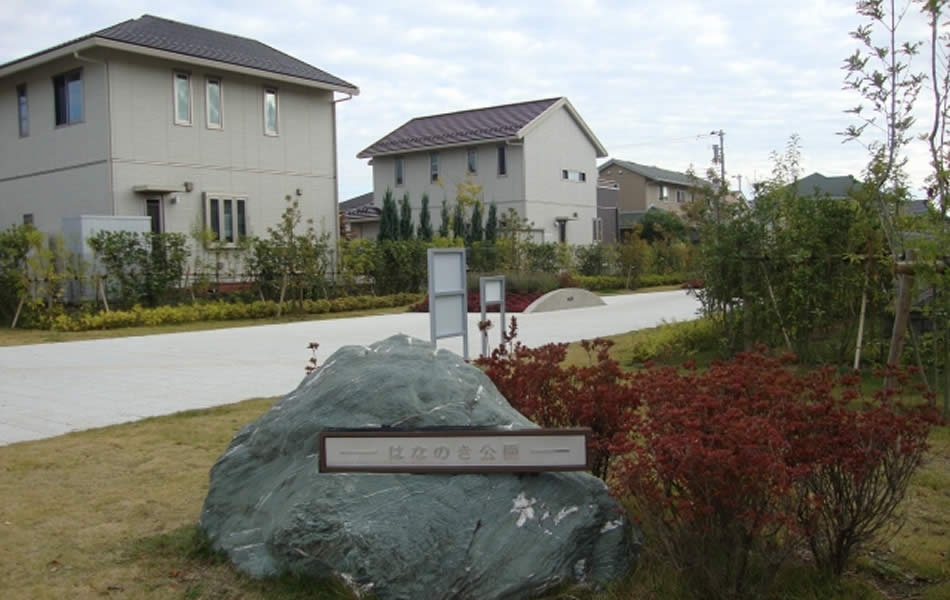 The park located at the center of the community.
The park located at the center of the community.
Owner’s voice
- The community’s management association is responsible for such things as preserving the value of the housing development by maintaining the attractiveness of green common-use areas, as well as the meeting place, while the residents' management association organizes other community activities. The two bodies share roles in this way, and cooperate extensively.
- The meeting place is the focal point for get-togethers by the residents, and is used not only for festivals, classes on health-related issues, and for hobby clubs and so on, but also for holding seminars with the participation of city officials and academics on matters such as crime-prevention and the environment.
- A committee was set up to hold consultations with the residents' associations of both the adjacent condominium building (which was completed at about the same time) and the adjacent existing single-family house development. Thereafter, the development of a sense of community among the three residential developments proceeded smoothly, and at present the meeting place is used—among other things—for holding meetings with the other residents' associations, and is making a contribution to the life of the whole area.
- Initially, Daiwa House laid down the rules for the use of the meeting place, and for the landscaping, but subsequently the residents themselves customized the rules and took the initiative in planning and holding events. Consequently, we believe that the level of enthusiasm among the residents for participation in such matters is high, and that a sustainable community consciousness has been formed.
- The park and the plaza are used as places where children can meet up on the way to and from school or the park.
- In my opinion it is very satisfactory that the landscaping rules are being observed and that the attractive appearance of the housing development is therefore being maintained.
- I am also satisfied with the large amount of greenery within the development.
- The residents are familiar with the concept underlying the design of our community, and I feel that there is a strong willingness to help maintain the community's appearance and reduce CO2 emissions.
- As the streets in front of the residences have been designated as pedestrian-priority, so as to limit the amount of traffic, our children can safely play in front of our house.
Note: These comments by a resident were made in 2019.
Comments by an Expert
Tomoko Iwata
Associate Professor, Environmental Systems Department, Shibaura Institute of Technology.
I became involved with SMA×ECO CITY Tsukuba Science City in relation to the Ministry of Land, Infrastructure, Transport and Tourism's projects for the construction of model communities making use of renewable energy generation and storage, and energy conservation at the levels of both the whole community and individual homes, as well as in transport.
I believe that a notable difference from other smart cities is that in the case of the organization of SMA×ECO CITY Tsukuba Science City, the data obtained on residential communities has been supplied to private companies and specialist institutions, including universities, for use in the future.
In my academic field of environmental systems studies, we base our projections of possible future changes in households and types of residence (e.g. simulations based on changes in the size and composition of families or the increased popularity of electric vehicles) on data obtained from actual residential communities such as this. However, this would be meaningless without feedback from residents on the results of our studies.
Because all the parties concerned—right from the start of the development of SMA×ECO CITY Tsukuba Science City—put a strong focus on creating a sense of "community" among the residents, the residents' voluntary self-governing bodies have been able to function effectively. The existence of communities such as this, which can give specialist academic institutions feedback on the findings of their studies, is extremely important. As a researcher, I hope that this community—with the residents as the core driving force—has the potential to evolve and become even better.
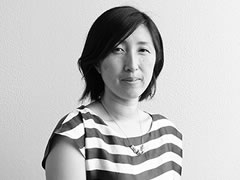
Daiwa House’s voice
SMA×ECO CITY Tsukuba Science City was the largest-scale "smart city" project among the many such projects being simultaneously undertaken by the Daiwa House Group.
I well remember the staff at Daiwa House engaging in many discussions about which methods we should adopt to install equipment in each home, enabling the owners to contribute to reducing manmade CO2 emissions, and about which rules—drawn from the experience of previous such communities—would facilitate the sustainable functioning of the residents' management association and the landscaping agreement. A great many interesting ideas were tossed around.
Since the first residents moved in to the community in 2013, I have heard that a great deal of community activities have been engaged in by the residents, together with the residents of the neighboring housing developments, staff of the municipality, and academics from a number of universities. I am proud to say that I was involved in this project.
-
 Japan's first, next-generation Net-Zero Energy community
Japan's first, next-generation Net-Zero Energy community
"SMA x ECO TOWN Harumidai" -
 New smart town where sales revenue from the town is returned as living support service
New smart town where sales revenue from the town is returned as living support service
"SMA x ECO TOWN Hidamari-no Oka" -
 Multigenerational community development to revitalize a new town
Multigenerational community development to revitalize a new town
"Midorigaoka and Miki Aoyama Housing Complex Revitalization Project" -
 A water town that utilizes the power of wind, sun, greenery and nature
A water town that utilizes the power of wind, sun, greenery and nature
"Lake Town Miwa-no Mori" -
 First community in Japan to take advantage of power interchange system among multiple single-family houses
First community in Japan to take advantage of power interchange system among multiple single-family houses
"SECUREA Toyota Kakimoto" -
 Community development that integrates residences with shops, including a large-scale commercial facility
Community development that integrates residences with shops, including a large-scale commercial facility
"Takao Sakura City" -
 The first net zero energy town in the Hokuriku Region, featuring full countermeasures against possible natural disasters
The first net zero energy town in the Hokuriku Region, featuring full countermeasures against possible natural disasters
"SECUREA Toyota Honmachi" -
 Each house is fitted with three batteries, and a home energy management system (HEMS) that enables easy tracking of energy usage
Each house is fitted with three batteries, and a home energy management system (HEMS) that enables easy tracking of energy usage
"SMA×ECO CITY Tsukuba Science City" -
 Achieving reconstruction through area management in cooperation with the people
Achieving reconstruction through area management in cooperation with the people
"Kyassen Ofunato" -
 Japan’s cutting-edge biomedical town
Japan’s cutting-edge biomedical town
"King Skyfront District A (under development)"



